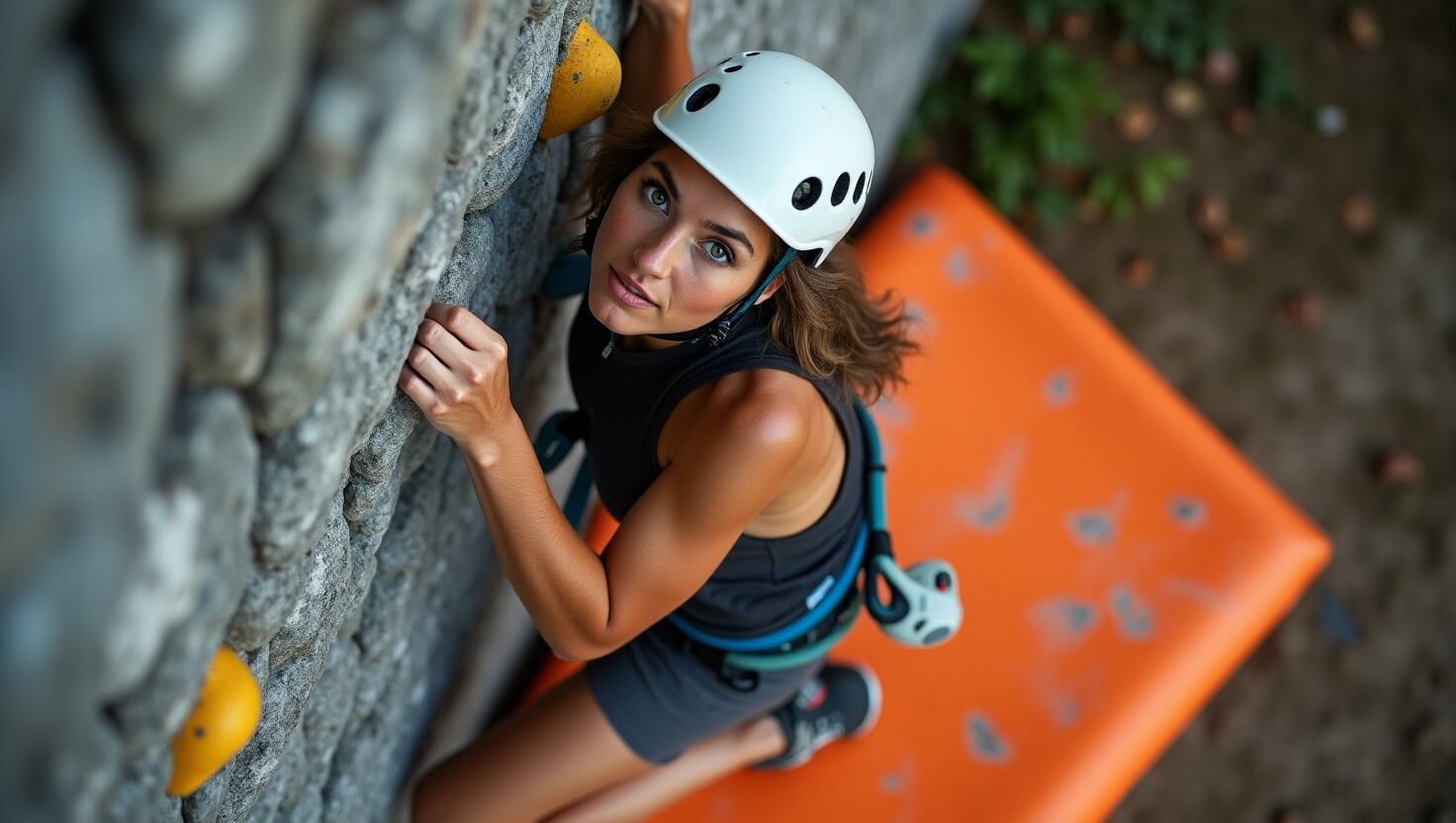Imagine standing at the base of your first outdoor boulder, chalk on your hands, heart pounding as you size up a V1 problem. You slip on a tricky hold, but instead of crashing onto jagged rocks, you land softly on a crash pad, ready to try again. That moment of relief is why every beginner boulderer needs a reliable crash pad.
Transitioning from the cushioned mats of a climbing gym to the unpredictable terrain of outdoor crags can feel intimidating, but the right crash pad provides safety and confidence to tackle new challenges. In this guide, we answer key questions like “Do you need a crash pad to boulder?” and “How many crash pads do you need?” while reviewing the best crash pads for bouldering beginners in 2025. With a focus on affordability, portability, and safety, we’ll help you choose the perfect pad to kickstart your outdoor climbing journey.
Why Do Beginners Need Crash Pads for Bouldering?
Bouldering, a rope-free style of rock climbing, involves short, intense routes called “problems” that test strength and technique. For beginners tackling V0-V4 problems (typically 6-12 feet high), crash pads are a critical piece of gear. Here’s why:
- Safety: Crash pads cushion falls, reducing the risk of sprains, bruises, or worse on rocky terrain. Outdoor Gear Lab (2025) reports that crash pads can absorb up to 50% of fall impact compared to bare ground, significantly lowering injury risk.
- Confidence: A soft landing lets beginners focus on climbing without fear, encouraging skill development. A Reddit user (r/bouldering, 2024) shared, “My first outdoor fall on a Black Diamond Impact pad made me realize I could keep trying without getting hurt.”
- Outdoor Necessity: Unlike gyms with thick, permanent mats, outdoor crags have uneven surfaces like rocks or roots, making crash pads essential for safe landings.
According to a 2023 survey on Mountain Project, 92% of beginner boulderers reported using crash pads for their first outdoor session, highlighting their importance.
How to Choose a Crash Pad for Bouldering Beginners
Selecting a crash pad can feel daunting with so many options, but focusing on key features simplifies the process. Here’s what beginners should look for:
- Size: Medium pads (36″ x 48″, ~12 square feet) offer enough coverage for low to medium-height problems while being easy to carry.
- Thickness: 4-5 inches of foam, blending closed-cell (durable, firm) and open-cell (soft, cushioned) layers, is ideal for beginners. Treeline Review (2025) recommends a minimum 4-inch thickness for adequate protection.
- Hinge Style:
- Hinge Pads: Fold flat for compact storage but may have gaps where rocks protrude (e.g., Black Diamond Impact).
- Taco Pads: Continuous foam for uneven terrain but bulkier to store (e.g., Petzl Alto).
- Portability: Lightweight pads (8-13 lbs) with shoulder straps or hip belts are beginner-friendly for hiking to crags.
- Durability: High-denier nylon (1000d-1680d) resists abrasion from rough surfaces.
- Extras: Features like shoe-cleaning mats or Velcro flaps for connecting pads add practicality.
How many crash pads do you need for bouldering? Solo beginners can start with one medium pad for low problems (6-10 feet). For group climbing or higher problems (10-15 feet), two pads are recommended to cover larger fall zones and eliminate gaps, as noted by Climber News (2023).
Best Crash Pads for Bouldering Beginners: Our Top Picks for 2025
After analyzing expert reviews, user feedback, and 2025 market trends, we’ve selected the top five crash pads for beginners, balancing safety, affordability, and ease of use. Prices are approximate based on retailer data.
- Black Diamond Impact (~$150-$200, 39″ x 48″, 4″ thick, 9 lbs)
- Why It Stands Out: Affordable and lightweight, this hinge-style pad is perfect for beginners tackling V0-V3 problems at local crags.
- Pros: Durable 1000d nylon, semi-stiff foam for balanced landings, fits most car trunks.
- Cons: Thinner foam limits use for highballs (15+ feet).
- Best for: Budget-conscious climbers starting outdoors.
- User Feedback: “The Impact was my go-to for my first season. It’s light and reliable!” – Reddit user, 2024.
- Metolius Session II (~$120-$170, 36″ x 48″, 4″ thick, 9 lbs)
- Why It Stands Out: Budget-friendly with practical features like a shoe-cleaning rug and storage flap.
- Pros: Lightweight, 900d nylon for durability, ideal for traverses and low problems.
- Cons: Smaller coverage for uneven terrain.
- Best for: Group bouldering or beginners on a budget.
- User Feedback: “Super portable and great value!” – X post, 2024.
- Mad Rock Mad Pad (~$130-$180, 36″ x 48″, 5″ thick, 11-12 lbs)
- Why It Stands Out: Thicker foam and Velcro flaps make it versatile for V3-V4 problems.
- Pros: Affordable, convertible to a chair, durable construction.
- Cons: Heavier and stiffer foam may feel firm for low falls.
- Best for: Beginners tackling slightly higher problems.
- User Feedback: “Best bang for your buck!” – Mountain Project user, 2023.
- Organic Climbing Simple Pad (~$200-$250, 36″ x 48″, 4″ thick, 10 lbs)
- Why It Stands Out: High-quality foam and eco-friendly production appeal to sustainability-focused climbers.
- Pros: Durable 1000d nylon, soft landings, customizable colors.
- Cons: Higher price, fewer extra features.
- Best for: Beginners valuing durability and eco-consciousness.
- User Feedback: “This pad lasts forever!” – X post, 2024.
- Petzl Alto (~$250-$300, 46″ x 39″, 5″ thick, 12.5 lbs)
- Why It Stands Out: Premium taco-style pad with multi-density foam for uneven terrain.
- Pros: Durable 1680d nylon, portable, great for remote crags.
- Cons: Expensive and heavier.
- Best for: Beginners transitioning to challenging outdoor settings.
- User Feedback: “Feels like landing on a cloud!” – Switchback Travel, 2024.
Comparison Table:
| Pad | Size | Thickness | Weight | Price | Best For |
|---|---|---|---|---|---|
| Black Diamond Impact | 39″ x 48″ | 4″ | 9 lbs | $150-$200 | Budget-conscious beginners |
| Metolius Session II | 36″ x 48″ | 4″ | 9 lbs | $120-$170 | Group bouldering |
| Mad Rock Mad Pad | 36″ x 48″ | 5″ | 11-12 lbs | $130-$180 | Higher problems |
| Organic Simple Pad | 36″ x 48″ | 4″ | 10 lbs | $200-$250 | Eco-conscious climbers |
| Petzl Alto | 46″ x 39″ | 5″ | 12.5 lbs | $250-$300 | Remote crags |
Sources: Outdoor Gear Lab (2025), Switchback Travel (2024), Treeline Review (2025).
How to Pick the Perfect Crash Pad for Your Bouldering Style
Choosing a crash pad depends on your budget, climbing environment, and style. Here’s how to make the right choice:
- Budget: Pads under $200, like the Metolius Session II or Mad Rock Mad Pad, offer reliable protection for cost-conscious beginners.
- Terrain: Hinge-style pads (e.g., Black Diamond Impact) work well on flat crags, while taco-style pads (e.g., Petzl Alto) excel on uneven terrain.
- Climbing Style: Solo climbers need one medium pad for low problems; group climbers benefit from two pads for larger fall zones (Climber News, 2023).
- Transport: Lightweight pads (8-10 lbs) like the Metolius Session II fit in compact cars or backpacks for short hikes.
Sustainable Crash Pads: Eco-Friendly Options for New Boulderers
Sustainability is a priority for many climbers, and eco-friendly crash pads combine performance with environmental responsibility:
- Organic Climbing Simple Pad: Made in a solar-powered factory, its durable design reduces waste by lasting longer.
- Mad Rock R3: Uses recycled EVA foam, offering robust protection with a lower environmental footprint.
- Why It Matters: Choosing sustainable gear aligns with the climbing community’s ethos of preserving outdoor spaces. A 2024 X post noted, “Organic’s pads are tough and eco-friendly—a win-win!”
A 2023 Outdoor Gear Lab survey found 65% of climbers consider sustainability when buying gear, a trend growing among beginners.
Top Mistakes Beginners Make with Crash Pads (and How to Avoid Them)
Even the best crash pad is only effective if used correctly. Avoid these common pitfalls:
- Improper Placement: Pads not covering the fall zone. Solution: Overlap pads and check for rocks underneath.
- Neglecting Spotters: Relying solely on pads for higher problems. Solution: Use a spotter to guide falls, especially for V3+ routes.
- Ignoring Terrain: Not adapting to uneven ground. Solution: Use taco-style pads for rocky crags.
- Overloading Pads: Stacking gear on pads. Solution: Keep pads clear to maintain foam integrity.
Start Bouldering Safely with the Right Crash Pad
The right crash pad transforms your outdoor bouldering experience, offering safety and confidence as you tackle new crags. From the budget-friendly Metolius Session II to the eco-conscious Organic Simple Pad, our 2025 picks cater to every beginner’s needs. Prioritize size, thickness, and portability to match your climbing style and terrain. Ready to hit the rocks? Share your crash pad experiences or ask questions or visit a local climbing gym to test pads before buying.




